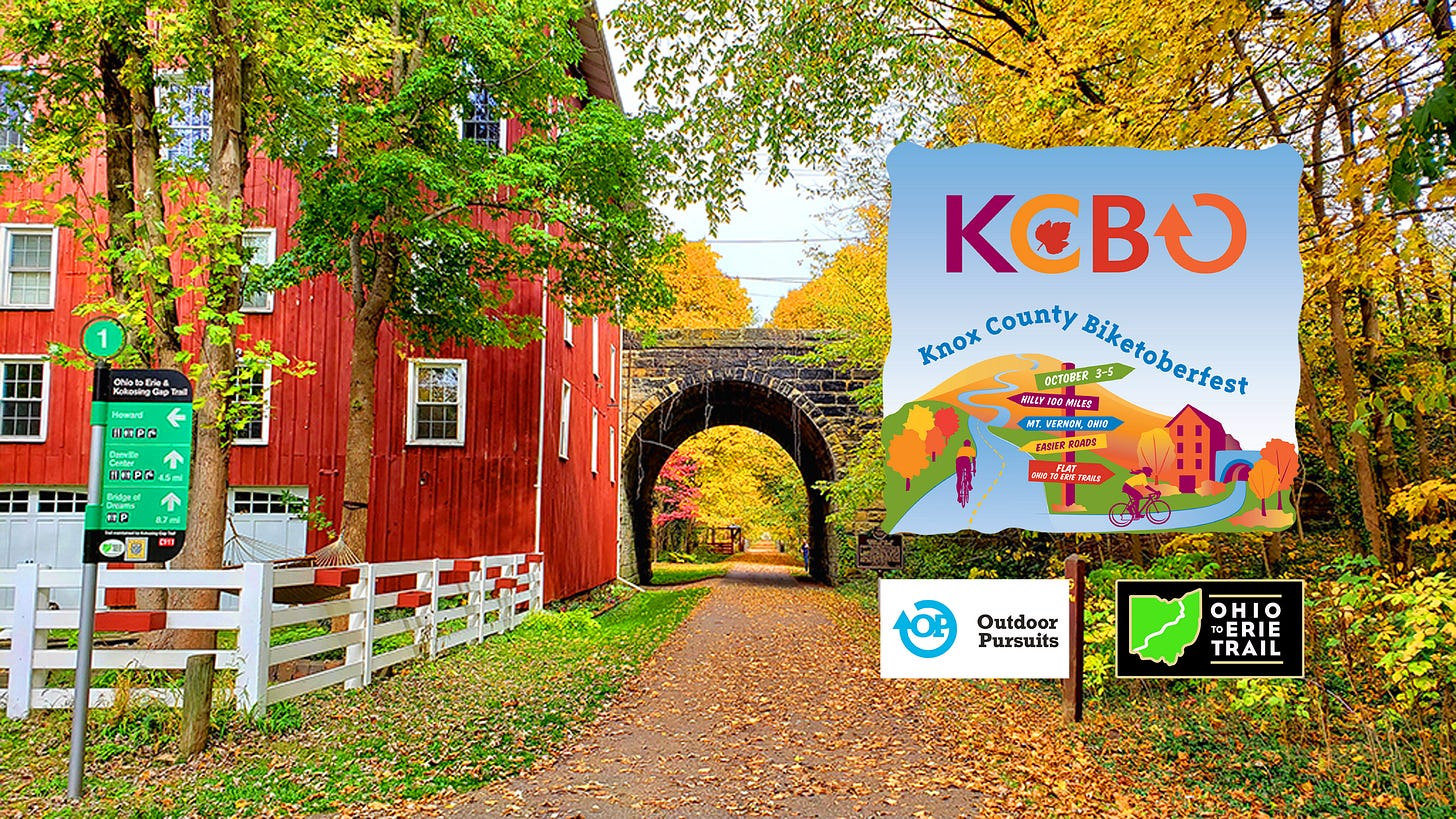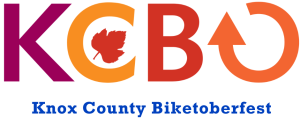
The Kokosing Gap Trail passes through the Howard Route 36 Arch
A New Chapter for Ohio Cycling
For many years, cyclists flocked to Greene County for a weekend cycling festival, showcasing Ohio trails and the Miami Valley Trail Network. It was a highlight on Ohio’s cycling calendar, bringing together riders of all ages, skill levels, and even cyclists from beyond Ohio’s borders to cycle the trail network from Xenia Station. When that event disappeared, so did Ohio’s celebrated trail-focused cycling festival.
This October, the legacy returns better and bigger. Knox County Biketoberfest (KCBO) is stepping in to fill that void, bringing a vibrant weekend cycling festival to the heart of the Ohio to Erie Trail. The Ohio to Erie Trail is partnering with Outdoor Pursuits, the organization behind KCBO GOBA and TOSRV, to honor two of the state’s cycling pioneers who opened new doors for cycling and trail enthusiasts in the state.
Outdoor Pursuits Cycling Legacy — Reimagined
Outdoor Pursuits has long been at the center of Ohio cycling history. Its legendary rides, Tour of the Scioto River Valley (TOSRV), Across Ohio Bicycle Adventure (XOBA), and the Knox County Bicycle Challenge, pushed cyclists to test their endurance on century rides and hilly country roads. KCBO builds on that legacy, but with a fresh focus that country roads and trails welcome everyone, not just those seeking endurance challenges.
The Ohio to Erie Trail stretches 326 miles from Cincinnati to Cleveland, with some of its most beautiful segments winding through Knox County. The Knox County Biketoberfest (KCBO) lets riders experience 36 of those miles with stunning scenery, charming trail towns, historic iron bridges, and the iconic Bridge of Dreams. Whether you’re looking for a relaxed family outing, a brisk autumn metric century, or something in between, KCBO captures the spirit of Ohio’s trails in one unforgettable weekend festival.
Knox County: Ohio’s Trail Destination
Knox County has become one of Ohio’s premier cycling destinations, thanks to its network of rail-trails that connect trail-friendly towns along scenic rivers and creeks passing through flat to rolling farm fields and woodlands. Families are drawn to pedal-friendly trails and family-oriented amenities. Mature cyclists ride for fitness, camaraderie, and to experience the outdoors. Adventure cyclists come to conquer one of the flattest metric or century rides in the state. Mount Vernon is a favored stop for cyclists taking on the 326-mile challenge from the Ohio River to Lake Erie.
KCBO routes showcase the best of Ohio trail riding: paved, low-elevation paths through scenic landscapes, ride lengths to match any schedule, and seamless connections beyond the county for cyclists eager to go the extra miles. It’s cycling without limits or age boundaries, an invitation to savor the outdoors in the full brilliance of Ohio’s autumn.
The timing is perfect: October in Knox County bursts with brilliant fall colors, crisp air, and farm markets brimming with pumpkins, apples, and harvest bounty. It’s the ideal season to slow your pace, pause along the trail, and capture Ohio at its most colorful time of the year.
Mount Vernon and Ariel-Foundation Park
KCBO’s hub is Ariel-Foundation Park in Mount Vernon, one of Ohio’s most stunning examples of industrial rebirth. Once a Pittsburgh Plate and Glass factory, it’s an award-winning park of woodlands, lakes, trails, industrial art, and the iconic Rastin Observation Tower. It’s the perfect season to climb the repurposed smokestack to take in the panoramic view of Knox County dressed in autumn’s colors.
Just half a mile away, Mount Vernon Depot, the former Cleveland, Akron, and Columbus (CA&C) Railroad depot, is the gateway welcoming cyclists into a vibrant, revitalized downtown with unique shops, dining, and a lively Friday evening Johnny Appleseed Festival with food trucks, entertainment, and more to kick off the weekend.
Honoring Trail Visionaries
KCBO is more than a cycling festival. It’s a tribute to the legacy of the railroads, whose abandoned corridors became the pathways of the Ohio to Erie Trail. This transformation was made possible by visionaries who saw overgrown railbeds not as wastelands, but as future corridors for commerce, tourism, and improving the health and well-being of Ohioans. The event will honor two of these pioneers whose efforts created the very trails we walk, hike, or pedal on today.
Jim Buchwald
Saturday’s routes honor Jim Buchwald, a Knox County industrialist and avid cyclist whose generosity and vision helped make Ariel-Foundation Park, local trails, and today’s vibrant Mount Vernon a reality. He was a frequent visitor to the Kokosing Gap Trail and an avid supporter of making Knox County a better place to live and visit.
Ed Honton
Sunday’s routes honor Ed Honton, the visionary behind the Ohio to Erie Trail and a pioneer in the rail-trail movement. What began as his dream in the early 1990s is now a reality that KCBO cyclists get to experience this weekend. Beyond cofounding the Ohio Bicycle Federation, Ed championed the creation of many trails and produced resources like 36 Bike Routes in Central Ohio. With Knox County at the heart of the Ohio to Erie Trail, there’s no better place to celebrate and carry his vision forward.
An Invitation to Ride This Autumn
Outdoor Pursuits and the Ohio to Erie Trail invite you to be part of this inaugural cycling weekend. Whether you’re a family out for a short ride, a seasoned cyclist chasing mileage, or someone rediscovering the joy of cycling, KCBO is designed for you for either a single day or the full weekend. Riders will find plenty of lodging options in Mount Vernon, from hotels to Airbnbs, along with convenient camping right at Ariel-Foundation Park—the heart of KCBO.
Sign up through the Outdoor Pursuits website for either a single day or the full weekend. Riders will find plenty of lodging options in Mount Vernon, from hotels to Airbnbs, along with convenient camping right at Ariel-Foundation Park—the heart of KCBO.
Register Today: https://outdoor-pursuits.org/knox-county-biketoberfest/
through the Outdoor Pursuits website
The proceeds benefit the Outdoor Pursuits Bicycle Development Fund, helping ensure a vibrant future for cycling in Ohio while honoring the passion of pioneers like Ed Honton and Jim Buchwald on trails and country roads.
This October, pedal into something new yet deeply rooted in Ohio’s cycling past. Join us in Mount Vernon and experience Knox County Biketoberfest—the newest premier cycling weekend on the Ohio to Erie Trail.
